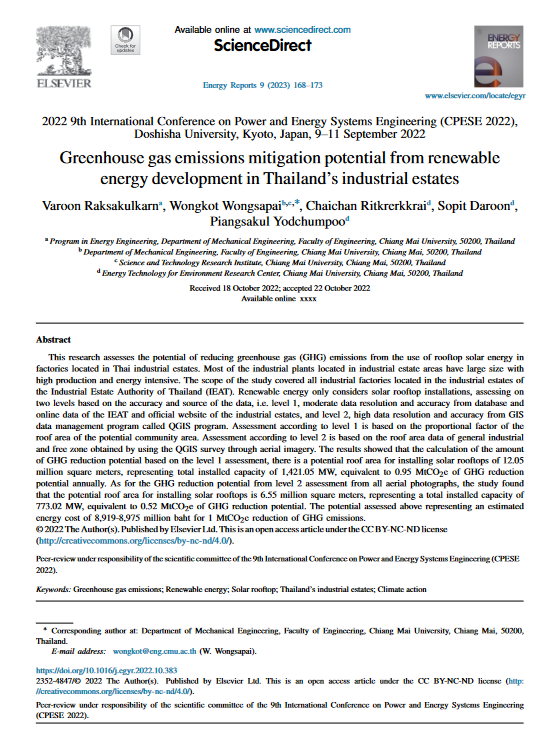
Keyword(s)
Author(s)
Varoon Raksakulkarn (a), Wongkot Wongsapai (b c), Chaichan Ritkrerkkrai (d), Sopit Daroon (d), Piangsakul Yodchumpoo (d)
Country(ies)
Publisher
Published Date
Access
DOI
This research assesses the potential of reducing greenhouse gas (GHG) emissions from the use of rooftop solar energy in factories located in Thai industrial estates. Most of the industrial plants located in industrial estate areas have large size with high production and energy intensive. The scope of the study covered all industrial factories located in the industrial estates of the Industrial Estate Authority of Thailand (IEAT). Renewable energy only considers solar rooftop installations, assessing on two levels based on the accuracy and source of the data, i.e. level 1, moderate data resolution and accuracy from database and online data of the IEAT and official website of the industrial estates, and level 2, high data resolution and accuracy from GIS data management program called QGIS program. Assessment according to level 1 is based on the proportional factor of the roof area of the potential community area. Assessment according to level 2 is based on the roof area data of general industrial and free zone obtained by using the QGIS survey through aerial imagery. The results showed that the calculation of the amount of GHG reduction potential based on the level 1 assessment, there is a potential roof area for installing solar rooftops of 12.05 million square meters, representing total installed capacity of 1,421.05 MW, equivalent to 0.95 MtCO 2e of GHG reduction potential annually. As for the GHG reduction potential from level 2 assessment from all aerial photographs, the study found that the potential roof area for installing solar rooftops is 6.55 million square meters, representing a total installed capacity of 773.02 MW, equivalent to 0.52 MtCO 2e of GHG reduction potential. The potential assessed above representing an estimated energy cost of 8,919-8,975 million baht for 1 MtCO 2e reduction of GHG emissions.
Cite:
Raksakulkarn, V., Wongsapai, W., Ritkrerkkrai, C., Daroon, S., & Yodchumpoo, P. (2023). Greenhouse gas emissions mitigation potential from renewable energy development in Thailand’s industrial estates. Energy Reports, 9, 168-173.